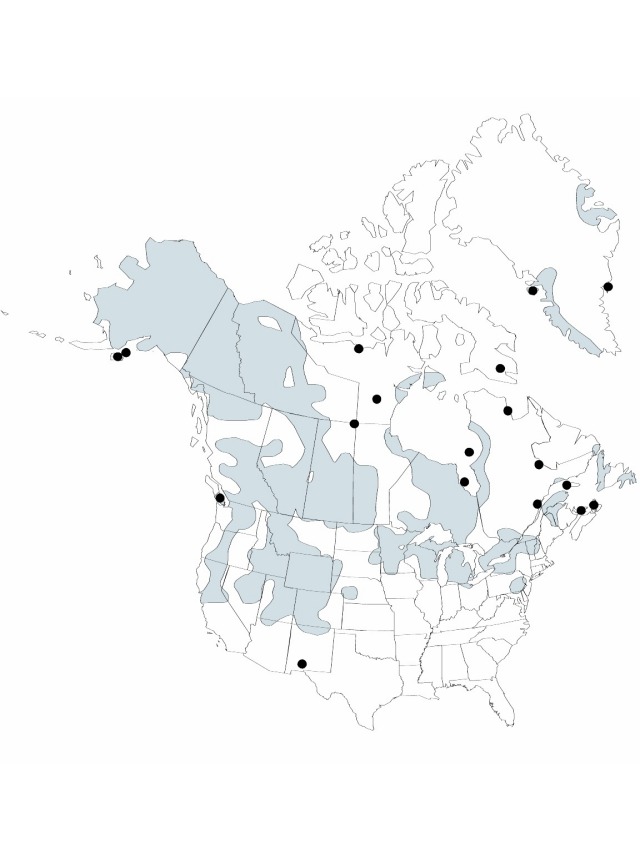Difference between revisions of "Stuckenia filiformis"
Flora fur das deutsche Volk 713. 1912.
FNA>Volume Importer |
FNA>Volume Importer |
||
| Line 8: | Line 8: | ||
}} | }} | ||
|common_names=Threadleaf-pondweed | |common_names=Threadleaf-pondweed | ||
| − | |basionyms={{Treatment/ID/ | + | |basionyms={{Treatment/ID/Basionym |
|name=Potamogeton filiformis | |name=Potamogeton filiformis | ||
|authority=Persoon | |authority=Persoon | ||
| + | |publication_title=Syn. Pl. | ||
| + | |publication_place=1: 152. 1805 | ||
}} | }} | ||
|synonyms= | |synonyms= | ||
| Line 24: | Line 26: | ||
-->{{Treatment/Body | -->{{Treatment/Body | ||
|distribution=Nearly worldwide. | |distribution=Nearly worldwide. | ||
| − | |discussion=<p>Three distinct subspecies seemingly apparently occur in North America. They are separated mainly by the size of the plants and the peduncle characteristics. <i>Stuckenia filiformis </i>subsp.<i> occidentalis</i> typically grows in cold deep water, standing or with a strong current. This variety tends to become robust and is easily confused with <i>Stuckenia vaginata</i> and <i>S. striata</i>. <i>Stuckenia filiformis </i>subsp.<i> alpina</i> is a much smaller plant typically growing in standing waters. <i>Stuckenia filiformis </i>subsp.<i> filiformis</i> is restricted to the far north. In the intermountain region of western United States is a more robust form that is quite similar to <i>S. filiformis </i>subsp.<i> alpina</i> but although it has previously been recognized as <i>Potamogeton</i> [<i>Stuckenia</i>] filiformis <i></i>var.<i> macounii</i> Morong (J. L. Reveal 1977b).</p><!-- | + | |discussion=<p>Three distinct subspecies seemingly apparently occur in North America. They are separated mainly by the size of the plants and the peduncle characteristics. <i>Stuckenia filiformis </i>subsp.<i> occidentalis</i> typically grows in cold deep water, standing or with a strong current. This variety tends to become robust and is easily confused with <i>Stuckenia vaginata</i> and <i>S. striata</i>. <i>Stuckenia filiformis </i>subsp.<i> alpina</i> is a much smaller plant typically growing in standing waters. <i>Stuckenia filiformis </i>subsp.<i> filiformis</i> is restricted to the far north. In the intermountain region of western United States is a more robust form that is quite similar to <i>S. filiformis </i>subsp.<i> alpina</i> but although it has previously been recognized as <i>Potamogeton</i> [<i>Stuckenia</i>] filiformis <i></i></i>var.<i><i> macounii</i> Morong (J. L. Reveal 1977b).</p><!-- |
--><p>Subspecies ca. 5 (3 in the flora).</p> | --><p>Subspecies ca. 5 (3 in the flora).</p> | ||
|tables= | |tables= | ||
| Line 68: | Line 70: | ||
|publication year=1912 | |publication year=1912 | ||
|special status= | |special status= | ||
| − | |source xml=https://jpend@bitbucket.org/aafc-mbb/fna-data-curation.git/src/ | + | |source xml=https://jpend@bitbucket.org/aafc-mbb/fna-data-curation.git/src/f6b125a955440c0872999024f038d74684f65921/coarse_grained_fna_xml/V22/V22_233.xml |
|genus=Stuckenia | |genus=Stuckenia | ||
|species=Stuckenia filiformis | |species=Stuckenia filiformis | ||
Revision as of 19:02, 24 September 2019
Stems freely branching proximally, sparsely branching distally, subterete, (10–)20–60(–100) cm. Leaves: length and width of those on main stem only slightly larger than those on branches; stipules with stipular sheaths often inflated on proximal portion of stem, 1–4(–9.5) cm, summit of midstem stipules tight to stem, ca. ± same width as stem, ligule 2–20 mm, distinct, especially on distal stipules; blade filiform or slenderly linear, 1–15 cm × 0.2–2(–3.7) mm, apex notched, blunt, or short-apiculate; veins 1–3. Inflorescences: peduncles terminal, erect, filiform to slender, 2–10(–15) cm; spikes cylindric to moniliform, 5–55 mm; verticels 2–6(–9). Fruits dark brown, obovoid, 2–3 × 1.5–2.4 mm; beak inconspicuous.
Distribution

Nearly worldwide.
Discussion
Three distinct subspecies seemingly apparently occur in North America. They are separated mainly by the size of the plants and the peduncle characteristics. Stuckenia filiformis subsp. occidentalis typically grows in cold deep water, standing or with a strong current. This variety tends to become robust and is easily confused with Stuckenia vaginata and S. striata. Stuckenia filiformis subsp. alpina is a much smaller plant typically growing in standing waters. Stuckenia filiformis subsp. filiformis is restricted to the far north. In the intermountain region of western United States is a more robust form that is quite similar to S. filiformis subsp. alpina but although it has previously been recognized as Potamogeton [Stuckenia] filiformis var. macounii Morong (J. L. Reveal 1977b).
Subspecies ca. 5 (3 in the flora).
Selected References
None.
Lower Taxa
Key
| 1 | Plants 20–100 cm; stipules on proximal portion of stem inflated, disintegrating with age; fruits often absent. | Stuckenia filiformis subsp. occidentalis |
| 1 | Plants 10–30 cm; stipules on proximal portion of stem tightly clasping or slightly enlarged, persistent; fruits common. | > 2 |
| 2 | Peduncles Peduncles with flowers and/or fruits 4 cm or more apart; leaves 0.2–0.5 mm wide. | Stuckenia filiformis subsp. Filiformis |
| 2 | Peduncles with flowers and/or fruits less than 4 cm apart; leaves to 1 mm widee. | Stuckenia filiformis subsp. alpina |